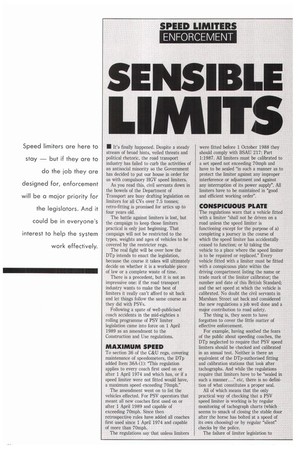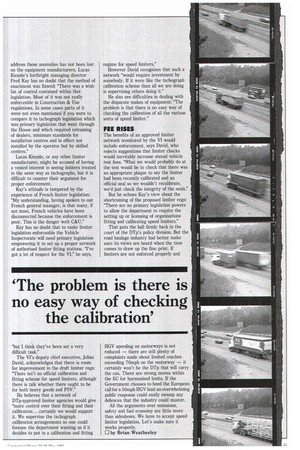NSIBLE
Page 32

Page 33

If you've noticed an error in this article please click here to report it so we can fix it.
1101
• It's finally happened. Despite a steady stream of broad hints, veiled threats and political rhetoric, the road transport industry has failed to curb the activities of an antisocial minority so the Government has decided to put our house in order for us with compulsory HGV speed limiters.
As you read this, civil servants down in the bowels of the Department of Transport are busy drafting legislation on limiters for all CVs over 7.5 tonnes; retro-fitting is promised for artics up to four years old.
The battle against limiters is lost, but the campaign to keep those limiters practical is only just beginning. That campaign will not be restricted to the types, weights and ages of vehicles to be covered by the restricter regs.
The real fight will be over how the Dip intends to enact the legislation, because the course it takes will ultimately decide on whether it is a workable piece of law or a complete waste of time.
There is a precedent, but it is not an impressive one: if the road transport industry wants to make the best of limiters it really can't afford to sit back and let things follow the same course as they did with PSVs.
Following a spate of well-publicised coach accidents in the mid-eighties a rolling programme of PSV limiter legislation came into force on 1 April 1989 as an amendment to the Construction and Use regulations.
MAXIMUM SPEED
To section 36 of the C&U regs, covering maintenance of speedometers, the Dip added Item 36A-(1): "This regulation applies to every coach first used on or after 1 April 1974 and which has, or if a speed limiter were not fitted would have, a maximum speed exceeding 70mph."
The amendment went on to list the vehicles effected. For PSV operators that meant all new coaches first used on or after 1 April 1989 and capable of exceeding 70mph. Since then retrospective rules have added all coaches first used since 1 April 1974 and capable of more than 70mph.
The regulations say that unless limiters were fitted before 1 October 1988 they should comply with BSAU 217: Part 1:1987. All limiters must be calibrated to a set speed not exceeding 70mph and have to be sealed "in such a manner as to protect the limiter against any improper interference or adjustment and against any interruption of its power supply". All limiters have to be maintained in "good and efficient working order".
CONSPICUOUS PLATE
The regulations warn that a vehicle fitted with a limiter "shall not be driven on a road unless the speed limiter is functioning except for the purpose of a) completing a journey in the course of which the speed limiter has accidentally ceased to function; or b) taking the vehicle to a place where the speed limiter is to be repaired or replaced." Every vehicle fitted with a limiter must be fitted with a conspicuous plate within the driving compartment listing the name or trade mark of the limiter calibrator; the number and date of this British Standard; and the set speed at which the vehicle is calibrated. No doubt the civil servants in Marsham Street sat back and considered the new regulations a job well done and a major contribution to road safety.
The thing is, they seem to have forgotten to cover the little matter of effective enforcement.
For example, having soothed the fears of the public about speeding coaches, the Dip neglected to require that PSV speed limiters should be checked and calibrated in an annual test. Neither is there an equivalent of the DTp-authorised fitting and calibration stations that look after tachographs. And while the regulations require that limiters have to be "sealed in such a manner..." etc, there is no definition of what constitutes a proper seal.
All of which means that the only practical way of checking that a PSV speed limiter is working is by regular monitoring of tachograph charts (which seems to smack of closing the stable door after the horse has bolted at a speed of its own choosing) or by regular 'silent" checks by the police.
The failure of limiter legislation to
address these anomalies has not been lost on the equipment manufacturers. Lucas Kienzle's forthright managing director Fred Kay has no doubt that the method of enactment was flawed: 'There was a wish list of control contained within that legislation. Most of it was not really enforceable in Construction & Use regulations. In some cases parts of it were not even mentioned if you were to compare it to tachograph legislation which was primary legislation that went through the House and which required retraining of dealers, minimum standards for installation centres and in effect not installed by the operator but by skilled centres."
Lucas Kienzle, or any other limiter manufacturer, might be accused of having a vested interest in seeing limiters treated in the same way as tachographs, but it is difficult to counter their argument for proper enforcement.
Kay's attitude is tempered by the experience of French limiter legislation: "My understanding, having spoken to our French general manager, is that many, if not most, French vehicles have been disconnected because the enforcement is poor. This is the danger with C&U."
Kay has no doubt that to make limiter legislation enforceable the Vehicle Inspectorate will need primary legislation empowering it to set up a proper network of authorised limiter fitting stations. "I've got a lot of respect for the VI," he says, "but I think they've been set a very difficult task."
The VI's deputy chief executive, Julian David, acknowledges that there is room for improvement in the draft limiter regs: "There isn't an official calibration and fitting scheme for speed limiters, although there is talk whether there ought to be for both heavy goods and PSV."
He believes that a network of DTp-approved limiter agencies would give "more control over their fitting and their calibration...certainly we would support it. We supervise the tachograph calibration arrangements so one could foresee the department wanting us if it decides to put in a calibration and fitting regime for speed limiters."
However David recognises that such a network "would require investment by somebody. If it were like the tachograph calibration scheme then all we are doing is supervising others doing it."
He also see difficulties in dealing with the disparate makes of equipment: "The problem is that there is no easy way of checking the calibration of all the various sorts of speed limiter."
PEE RISES
The benefits of an approved limiter network monitored by the VI would include enforcement, says David, who rejects suggestions that limiter checks would inevitably increase annual vehicle test fees. "What we would probably do at the test would be to check that there was an appropriate plaque to say the limiter had been recently calibrated and an
official seal so we wouldn't recalibrate, 1 we'd just check the integrity of the seals."
But he echoes Kay's view about the shortcoming of the proposed limiter regs: "There are no primary legislation powers to allow the department to require the setting up or licensing of organisations fitting and calibrating speed Limiters."
That puts the ball firmly back in the court of the DTp's policy division. But the road haulage industry had better make sure its views are heard when the time comes to draw up the fine print. If limiters are not enforced properly and HGV speeding on motorways is not reduced — there are still plenty of complaints made about limited coaches exceeding 70mph on the motorway — it certainly won't be the Dip that will carry the can. There are strong moves within the EC for harmonised limits. If the Government chooses to heed the European call for a 50mph HGV limit an overwhelming public response could easily swamp any , defences that the industry could muster.
All the arguments over emissions, safety and fuel economy are little more than sideshows. We have to accept speed limiter legislation. Let's make sure it works properly.
0 by Brian Weatherley








































































































